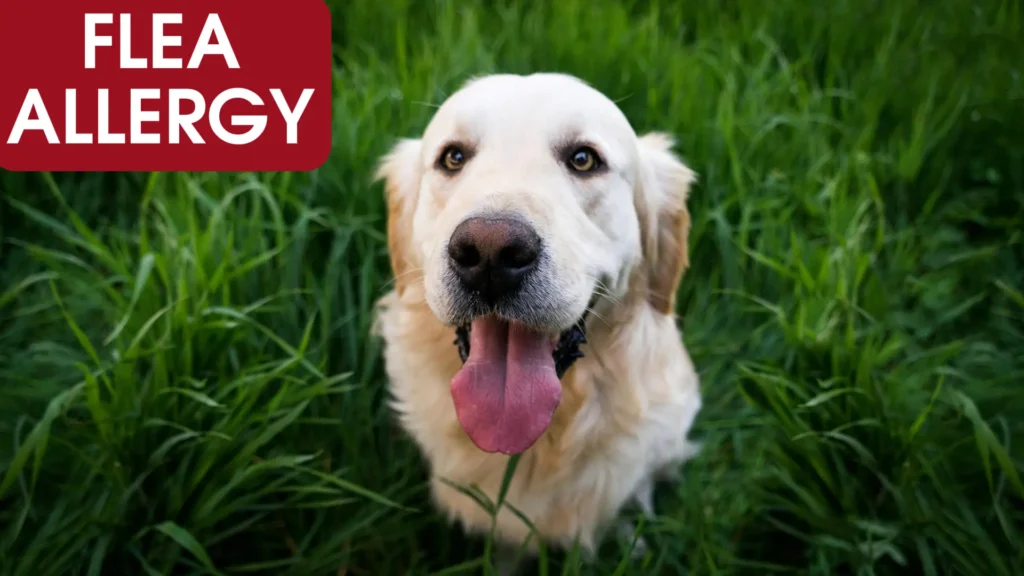Allergies in dogs occur when their immune system overreacts to typically harmless elements, such as pollen, food ingredients, or flea saliva. Recognizing the signs of allergies and understanding how to manage them is essential for ensuring your furry companion leads a healthy life.
Types of Dog Allergies
These allergies are typically categorized into four main types.
- Food allergies
- Environmental allergies (atopic dermatitis)
- Flea allergy dermatitis
- Contact allergies.
Food Allergies
Food allergies are among the most common types of allergies in dogs. They occur when a dog’s immune system mistakenly identifies a particular ingredient in their diet as harmful. This triggers an immune response and upset your dog’s stomach.
This reaction is different from food intolerance. Food intolerance primarily affects the digestive system and food allergies involve the immune system.
Common allergens in dog food include proteins like beef, chicken, lamb, dairy, eggs, and grains such as wheat and soy.
Symptoms of Food Allergies
The symptoms of food allergies in dogs manifest on the skin or in the gastrointestinal tract. While these signs can vary from dog to dog, some of the most common symptoms include:
- Persistent scratching, licking, and chewing, especially around the ears, paws, groin, and rear end.
- Recurrent inflammation or infections in the ears. This sometimes accompanies odor and discharge.
- Gastrointestinal issues like vomiting, diarrhea, and frequent bowel movements.
- Irritated and swollen areas of skin that may appear raw due to excessive scratching.
- Localized areas of redness, warmth, and inflammation caused by constant irritation.
In severe cases, food allergies can lead to secondary infections, such as bacterial or yeast infections.
Management of Food Allergies
Managing food allergies requires identifying and eliminating the offending ingredient from your dog’s diet.
Conducting an elimination diet is one of the most reliable ways to identify food allergens. Under the guidance of a veterinarian, you’ll feed your dog a novel protein and carbohydrate source (e.g., duck and sweet potato). Once symptoms improve, you can gradually reintroduce potential allergens to pinpoint the culprit.
Switching to hypoallergenic or limited-ingredient diets can help prevent allergic reactions. These diets are formulated with novel proteins and carbohydrates that are less likely to trigger an immune response. Some brands offer hydrolyzed protein diets. The proteins are broken down into smaller molecules that are less likely to be recognized by the immune system.
All human foods aren’t suitable for dogs. Some contain ingredients that can trigger allergies in dogs. Avoid feeding your dog table scraps. Always check pet treats for hidden allergens.
Omega-3 fatty acids help reduce inflammation and support skin health. Probiotics also aid in maintaining a healthy gut microbiome. This plays a role in managing food sensitivities.
Environmental Allergies
Environmental allergies, also known as atopy or atopic dermatitis, occur when dogs react to airborne allergens in their surroundings. These allergens include pollen from trees, grasses, and weeds, mold spores, dust mites, and household chemicals.
Environmental allergies are seasonal. You should take extra care to keep your dog safe from seasonal allergy influence. Your dog can be affected year-round if exposed to indoor allergens like dust mites and mold.
Symptoms of Environmental Allergies
The symptoms of environmental allergies are primarily dermatological. The allergens cause irritation when they come into contact with the dog’s skin. Common signs include:
- Dogs with environmental allergies often scratch themselves incessantly, particularly on their paws, belly, and face.
- The skin appears red, inflamed, and scaly due to constant irritation.
- Prolonged scratching and licking lead to patchy hair loss and thinning fur.
- Some dogs exhibit respiratory symptoms, such as sneezing, coughing, and eye discharge.
- Chronic ear infections are common in dogs with environmental allergies
- In severe cases, untreated environmental allergies can lead to secondary skin infections, hot spots, and significant discomfort for the dog.
Management of Environmental Allergies
Eliminating environmental allergens entirely isn’t practical. But there are several steps you can take to minimize your dog’s exposure and alleviate symptoms.
Bathe your dog frequently with hypoallergenic shampoos designed to soothe irritated skin and remove allergens from their coat. Be sure to use lukewarm water to avoid further drying out their skin.
Use air purifiers with HEPA filters in your home to reduce airborne allergens like pollen, dust mites, and mold spores. This is especially helpful for dogs with indoor allergies.
Keep your home clean by vacuuming carpets and upholstery regularly. Wash your dog’s bedding weekly, and wipe down surfaces to remove dust and dander.
Your veterinarian may recommend antihistamines, corticosteroids, and other medications to manage itching and inflammation. In some cases, immunotherapy may be prescribed to desensitize your dog to specific allergens over time.
Grass and pollen are sensitive for some dogs. Consider using protective clothing during walks.
During peak allergy seasons, try to limit your dog’s time outdoors. Pollen counts are high during spring and fall. After outdoor activities, wipe your dog’s paws and coat with a damp cloth to remove allergens.
Flea Allergy Dermatitis
Flea allergy dermatitis (FAD) is one of the most common and frustrating allergies in dogs. It occurs when a dog has an allergic reaction to flea saliva. It is injected into their skin during a flea bite.
Flea allergy dermatitis can be triggered by just a single flea bite. This hypersensitivity causes intense itching and discomfort. This often leads to secondary skin issues if left untreated.

Symptoms of Flea Allergy Dermatitis
The condition can manifest in various ways depending on the dog’s sensitivity and the severity of the infestation. Common symptoms include:
- Dogs with flea allergy dermatitis scratch excessively around the base of the tail, lower back, groin, and hind legs. This area is a prime target for flea bites.
- Red, inflamed areas of skin develop due to constant scratching and chewing. These hot spots become painful and ooze fluid.
- Prolonged scratching and biting lead to patchy hair loss and thinning fur in affected areas.
- The broken skin from excessive scratching creates an entry point for bacteria and yeast. This increases the risk of infections. These infections cause additional redness, swelling, and odor.
- Flea bites can leave behind small scabs or crusts on the skin. This is referred to as “flea dirt” or flea debris.
Management of Flea Allergy Dermatitis
Managing flea allergy dermatitis requires a two-pronged approach: eliminating fleas and preventing future infestations.
Use high-quality flea prevention products year-round. Options include topical treatments, oral medications, flea collars, and sprays. Always consult your veterinarian to choose the safest and most effective product for your dog.
Check your dog’s coat frequently for signs of fleas, flea dirt (tiny black specks that resemble pepper), or irritated skin. Pay close attention to the base of the tail, belly, and armpits. Fleas generally tend to congregate in these areas.
If you discover fleas on your dog, treat the infestation immediately. Bathe your dog with a flea shampoo designed to kill fleas and soothe irritated skin. Follow up with a vet-recommended flea treatment to ensure all stages of the flea life cycle are eliminated.
Fleas thrive in warm and humid environments, so it’s crucial to address your home and yard. Wash your dog’s bedding in hot water weekly, vacuum carpets and upholstery frequently. Consider using flea sprays or foggers in your home. In outdoor spaces, keep grass trimmed and use pet-safe insecticides if necessary.
If your dog develops secondary skin infections, consult your veterinarian. They may prescribe antibiotics, antifungal medications, or topical creams to address the infection and promote healing.
Fleas can hitch a ride on clothing or other pets. Consistent flea prevention is essential to protect your dog from flea allergy dermatitis.
Contact Allergies
Contact allergies occur when a dog’s skin comes into direct contact with an irritating substance. These allergens include fabrics, cleaning products, plants, rubber toys, and plastic food bowls. Unlike food or environmental allergies, contact allergies are localized. The reaction typically appears only at the point of contact.
Symptoms of Contact Allergies
The symptoms of contact allergies are generally mild but can cause significant discomfort for the dog. Common signs include:
- The affected area becomes red, inflamed, and intensely itchy. Dogs lick, chew, and scratch the irritated skin to relieve the discomfort.
- In some cases, the skin develops raised welts (hives) at the site of contact.
- A rash may appear as small bumps, blisters, and scaly patches on the skin.
- Persistent irritation can lead to localized hair loss in the affected area.
The location of the symptoms help identify the source of the allergy. For example, rashes on the abdomen might suggest contact with grass or carpet, while irritation around the neck could indicate a reaction to a collar or tag.
Management of Contact Allergies
Managing contact allergies involves identifying and removing the offending substance from your dog’s environment. Here are some practical steps:
Carefully observe your dog’s behavior and environment to pinpoint the source of the allergy. For example, if your dog develops a rash after wearing a new collar, switch to a hypoallergenic alternative made from cotton or leather.
Many household cleaners contain harsh chemicals. These products can irritate a dog’s skin. Opt for natural, non-toxic cleaning products labeled as pet-safe. Avoid using strong detergents or fabric softeners on your dog’s bedding.
If your dog is prone to outdoor irritants like grass, weeds, and asphalt, consider protective measures. For example, lightweight jackets can shield their skin during walks, while booties can prevent contact with allergenic plants.
Replace plastic food and water bowls with stainless steel. Plastic can harbor bacteria and cause allergic reactions in some dogs. Similarly, choose hypoallergenic toys made from natural fabric.
If your dog is exposed to potential allergens like grass or pollen, bathe them with a gentle, hypoallergenic shampoo to remove irritants from their coat. Be sure to dry their skin thoroughly afterward to prevent moisture buildup.
General Tips for Managing Dog Allergies
Allergies significantly impact a dog’s quality of life. With proper identification and management, most dogs can live comfortably despite their sensitivities.
Food Allergies require careful dietary adjustments and patience to identify the offending ingredient. An elimination diet and hypoallergenic foods are essential tools in managing this type of allergy.
Environmental Allergies demand a combination of environmental control, regular grooming, and medical intervention to keep symptoms under control. Reducing exposure to allergens and providing relief through medications and immunotherapy can make a world of difference.
Flea Allergy Dermatitis requires diligent flea prevention and environmental control to eliminate fleas and prevent future infestations. Regular inspections, prompt treatment, and year-round prevention are essential for managing this condition.
Contact Allergies demand careful observation to identify and remove the offending substance. Using hypoallergenic products, protecting your dog’s skin, and maintaining a clean environment help minimize exposure to irritants.
If you suspect your dog has allergies, consult your veterinarian for a proper diagnosis. Allergy testing, blood work, and skin biopsies may be necessary to pinpoint the cause.
A strong skin barrier can help reduce the impact of allergens. Ensure your dog receives a balanced diet rich in omega-3 fatty acids. This promotes skin health and reduce inflammation.
Stress can exacerbate allergic reactions. Provide your dog with plenty of exercise, mental stimulation, and a calm environment to support their overall well-being.
If your dog suffers from environmental allergies, pay attention to seasonal patterns. For example, pollen levels are higher in spring and summer, while mold spores may peak in fall.
Some pet owners find relief for their dogs through natural remedies like coconut oil, oatmeal baths, and herbal supplements.
When to Seek Professional Help
While mild allergies can often be managed at home, severe symptoms require professional intervention. Chronic itching, recurring infections, and significant hair loss should not be ignored. Your veterinarian can recommend advanced treatments tailored to your dog’s needs.
By addressing these allergies promptly and effectively, you can ensure your dog remains comfortable and free from unnecessary suffering. Remember, early intervention and consistent management are key to keeping your furry friend happy and healthy.




